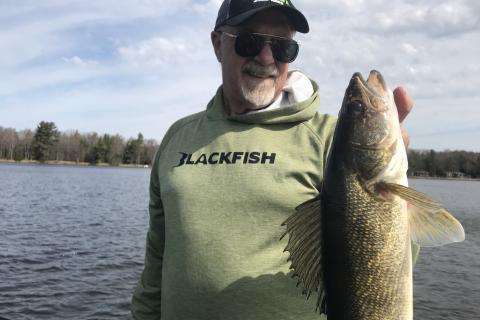
by Steve Worrall
Walleye anglers from the upper Midwest love tradition and have the tendency to stick to it. Visit any lake or river during opening weekend of walleye; you’ll see minnow buckets, crawlers, and jigs in play by most anglers. Nothing wrong with that approach, it’s popular for a reason…it works! Is live bait the best presentation? I suggest there’s an option you should try.

I helped pioneer walleye specific fishing jigs and plastics back in the 1970’s as the soft plastic lure revolution began led by brands like Mr. Twister and Mar Lyn. I was searching for a technique that would keep my hands out of cold minnow buckets, keep the crawler bedding mess out of my boat, and allow me to fish any early season walleye haunt I wished to without switching gear.
A Rockford, IL and Wauconda IL based group of anglers had already adapted the technique for muskies. Top Midwestern anglers Tony Portincaso and Jimmy Cairnes fished with my father a lot and our family kitchen table was the epicenter for gear innovation by these fishing buddies for a decade. What developed there in the 60’s is now a standard for several bass fishing techniques, but for most walleye anglers it just never really caught on.
The Fishing Gear
Jigs: The biggest difference in the set-up is the size and weight of the lures we use. Let’s break that down starting with the jigs.

The in style jigs available back then were primarily round head jigs, and 1/16 th ounce to 1/8 th ounce. The big problem there is the hooks were too small, and a round jig gets snagged up fast in any cover. My Dad ground the bottom off a round jig, filed the sides so they came to a point at the hook eye, and the first stand-up style jig was born. Hook size went up to 1 on a 1/16 th ounce and 1/0 to 2/0 on the 1/8th and 1/4-ounce models. The commercial adaptation of this handmade jig was the Power Head, now known widely as a stand-up fishing jig. This jig lands standing up after each short retrieve, breaks through vegetation effectively and avoids getting snagged in rock as a result.
 Plastics: My son Keith loves the Berkley Gulp Night Crawler in Watermelon Pearl . I like those as well but prefer a Fliptail Lures Baby Creature in Motor Oil or No Fish Yellow. I developed that lure back in the 1970s working with Stembridge Products and new owners rescued the tooling and re-introduced the brand a couple years ago.
Plastics: My son Keith loves the Berkley Gulp Night Crawler in Watermelon Pearl . I like those as well but prefer a Fliptail Lures Baby Creature in Motor Oil or No Fish Yellow. I developed that lure back in the 1970s working with Stembridge Products and new owners rescued the tooling and re-introduced the brand a couple years ago.
The Creature moniker was coined by a friend of mine, Steve Quandt, on a fishing trip. When I tied on a prototype, he asked me what kind of ‘creature’ that thing was, and the name stuck. Since then, ‘creature baits’ has become a generic term. Twister type tails work as well, but for some unknown reason, not as well as the Gulp Crawler and Baby Creature. 4” lizard type baits also produce. Stay away from the heavier, more bulky plastics, as they slow drop speed, which is important.
Leaders: Usually walleye and leaders are mutually exclusive, but the type of structure we are fishing shallow walleyes also holds pike and muskies. No leader and we’d lose 5 or more lures per trip to toothy critters and miss out on additional action. 14-pound fluorocarbon fishing line or light wire leaders are the ticket. The fish literally don’t seem to be bothered by a leader at all.
Fishing Line: Our primary choice is 12-pound Berkley Trilene line. The reason for heavier line is to absorb the shock with

less stretch busting a creature jig through reeds, cabbage, and other vegetation. 8-pound would be the minimum, and line that light is likely to suffer a few break offs in reeds.
Rod: Medium to medium heavy 6’ to7’ graphite spinning rods are our choice. A line starting at 8 to as high at 17-pound mono is perfect. Superlines are also workable, look at 10-pound to 20-pound for that application.
Reel: We prefer spinning tackle for speed of retrieve and easy casting with the light creature baits. Spinning tackle is also easier on the wrist to bust through vegetation. A size 20 fishing spinning reel is usually perfect with retrieve ratios in the mid 5s.
Fishing Technique: This is where tradition really gets destroyed. We are moving those jigs much faster than most walleye anglers would accept.
The shallower the water, the lighter the jig. It’s best to have about a one foot per second drop speed. Cast the jig into a reed pocket, patch of emerging cabbage, or to the edge of a hard bottom shallow shelf, let the lure hit the bottom, point the rod at the lure and reel two turns of the handle quickly. This will pop the creature up off the bottom and forward, allowing for a couple seconds drop time. That’s when most hits occur! Don’t use the rod tip, your rod tip position needs to be hookset ready, and jigging with the rod tip is too slow. A hit will be felt as a sharp ‘tic’. Set the hook straight up, hard!
Structure: Early season shallow water walleyes will feed outside the spawning areas in reeds, inside emerging weed patches, and on sand and rock structures where no other cover is available. We live in the North and find the walleyes on the shallow structure all the way through June. Try this technique adapted to your waters, and you will be as hooked on it as the walleyes you will catch!
- 4223 views

